January 31, 2022 feature
Garnet petrochronology: Revealing the lifetime and dynamics of magma at Somma-Vesuvius
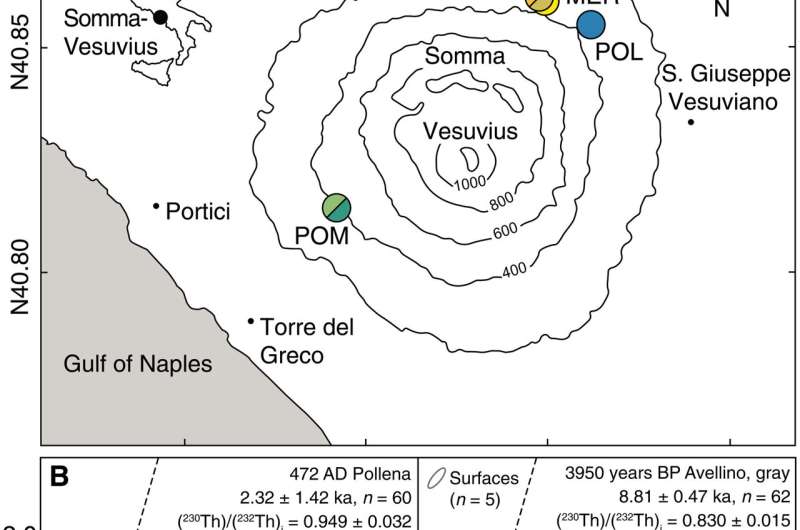
Somma-Vesuvius is an iconic active volcano, with historic and archaeological records of hazardous eruptions. Geologists have conducted petrologic studies (microscopic studies of rocks) of eruptive products to provide insights to the evolving magma reservoir prior to eruption. In a new report now published in Science Advances, Jörn-Frederik Wotzlaw and a team of researchers in earth sciences, geochemistry, and petrology in Switzerland, Italy and France quantified the time-frame of shallow crustal storage and documented the evolution of phonolithic magmas before major eruptions of the Somma-Vesuvius. Using garnet uranium-thorium petrochronology, which describes a link between the time-scale and rock formation processes, geoscientists have suggested progressively shorter pre-eruption residence times during the lifespan of the volcano. The research showed the presence of distinct phonolite (fine-grained volcanic rock) magma batches throughout most of the volcano's evolution to prevent the ascent of mafic magmas from longer-lived and deeper reservoirs. The frequent lower-energy eruptions from this deep reservoir suggested future Plinian eruptions to be unlikely without centuries of volcanic quiescence. The team also noted how the features of long-lived, deep-seated reservoirs and transient upper magma chambers are common features of subvolcanic plumbing systems.
Dynamics of magma storage under Somma-Vesuvius
Volcanic hazards are life-threatening and can impact millions of people worldwide. For instance, the most volatile eruptions produce ash falls and pyroclastic flows that can destroy entire cities. Somma-Vesuvius is an active volcano located in the Campanian Plain in Southern Italy with a remarkably well preserved record of hazardous eruptions that are based on written documents of Roman and Christian chroniclers and archaeological excavations. These include eruptions that occurred in the history books that describe the buried Roman cities of Pompeii and Herculaneum. The lifetime of the eruption-feeding magma chambers and the processes from magma chamber assembly to eruption, constrained in the absence of actinide-rich accessory minerals including zircon and allanite. The team obtained geochemical data from two multigrain garnet fractions at Somma-Vesuvius to indicate the presence of voluminous melt-rich reservoirs present for several thousand years prior to violent eruptions. To understand the timescales and conditions of phonolite magma storage, Wotzlaw et al. recently developed methods for in situ Uranium-Thorium (U-Th) disequilibrium dating of calcium rich garnet phenocrysts using laser ablation inductively coupled plasma mass spectrometry. Together with detailed textural and geochemical characterization of U-Th dated crystals, the team obtained a comprehensive petrochoronology framework to assess the time-scales and dynamics of magma storage under Somma-Vesuvius. The team combined the outcomes from Somma-Vesuvius with data obtained from other volcanoes worldwide to investigate variable storage regimes and understand the processes and methods underlying subvolcanic magma storage.
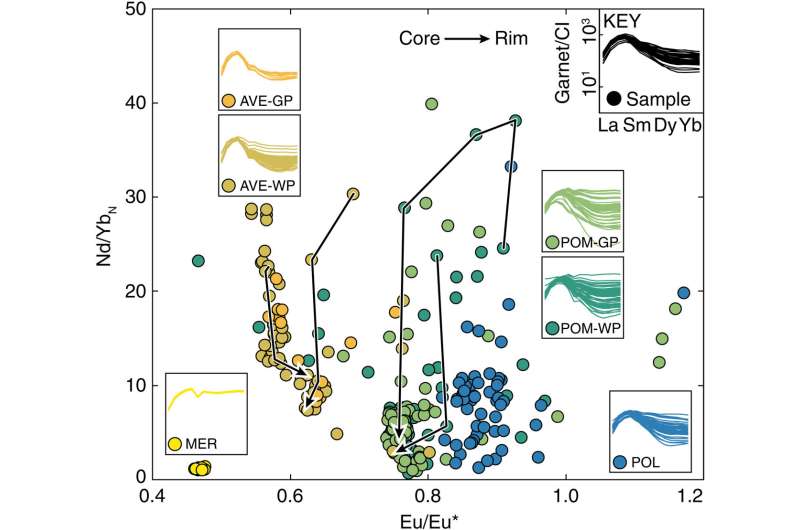
The team performed a total of 738 U-Th isotope analyses on garnet crystals on both crystal interiors and the outermost rims of the unpolished crystals obtained from four Plinian and Sub-Plinian eruptions of Somma-Vesuvius. The analyses focused on four sites including the Mercato eruption, 8890 years before the present (B.P.), the Avellino eruption, Pompeii eruption and the Pollena eruption. The U-Th isotope systematics of garnet phenocrysts provided well-defined internal isochrons to provide precise estimates of garnet crystallization ages. Avellino garnets in particular showed small apatite inclusions with low U/Th ratios. They assumed the resultant small inclusions to be related to boundary layer crystallization, isochronous with the garnet host. The inclusions were not assumed to have compromised the interpretation of isochron dates as the garnet ages. The team also assessed the interior domains of garnet phenocrysts extracted from pumices of the 8890 year old Mercapto eruption to yield a U-Th ratio of 14.56 ± 1.25 ka in excellent agreement with previous results. The interior domains of garnet from the 3590 year old Avellino eruption yielded U-Th isochron dates of 8.93±0.29 ka for white pumices and 8.81±0.47 ka for crystals from gray pumices. The garnets from the historic AD 79 Pompeii and 472 Pollena eruptions yielded indistinguishable U-Th isochron dates.
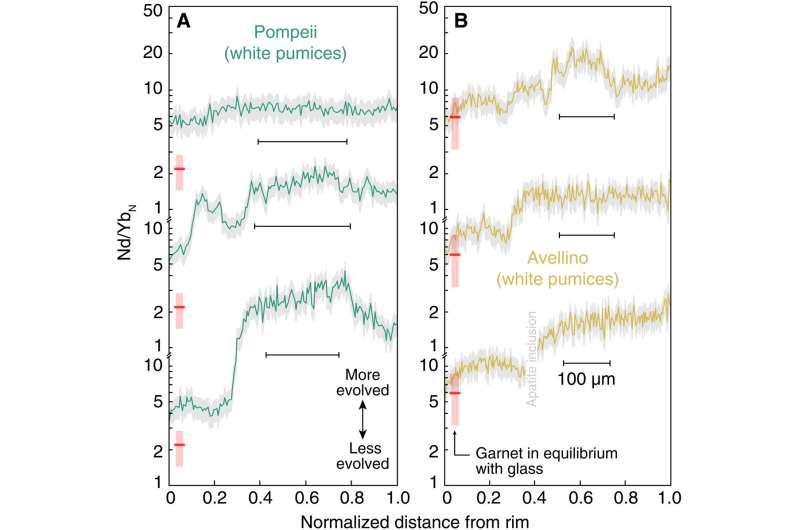
Major and trace elemental composition of garnet phenocrysts.
The compositional variations of the garnet phenocrysts provided insights into the magma reservoir dynamics and heterogeneity of garnet growth. Each eruption showed compositionally distinct garnet populations, although garnets from the phonolithic (white) and the tephriphonolitic (gray) pumices were compositionally indistinguishable in the geochemically zoned deposits, suggesting their crystallization from similar host melts prior to the formation of compositional layering. The garnets displayed variations from slightly to strongly fractioned rare earth element (REE) patterns caused by heavy rare earth element (HREE) concentrations. While Wotzlaw et al. showed how garnet controlled most of the rare earth element budget in Vesuvius phonolites, the variations originated from variable heavy rare earth element depletion of the melt during crystallization of a garnet-bearing mineral assemblage. The Avellino, Pompeii and Pollena garnets showed moderate europium (Eu) anomalies indicative of enriched or depleted europium concentrations in the mineral. These observations also aligned with phase equilibria experiments. Furthermore, the garnet phenocrysts of the Mercato eruption were homogenous, relative to major trace element compositions consistent with limited geochemical variability in the Mercato pumices. In contrast, garnets from the Avellino, Pompeii and Pollena eruptions were compositionally zoned in major and trace elements. Such complexities reflected the large-scale heterogeneities and dynamic compositional fluctuations in the host magmas during magma assembly and crystallization.
-
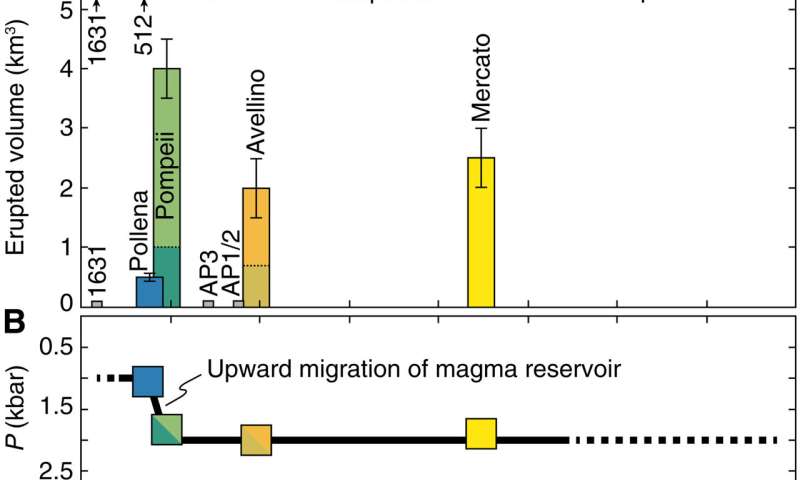
Comparison of erupted volumes of Somma-Vesuvius phonolites, magma storage pressure, and crystal residence times. (A) Estimated erupted volumes of major Plinian and sub-Plinian eruptions of Somma-Vesuvius. Also shown are the prominent intervals without any record of eruptions preceding the Mercato and Avellino eruptions, the “AP” eruptive interval, and periods of semipersistent (phono-)tephritic eruptions (black bars). (B) Storage pressure of Somma-Vesuvius phonolites based on experimental phase equilibria (black line) and chlorine solubility (symbols). (C) Pre-eruption residence time of garnet phenocrysts as a function of garnet crystallization age illustrating the decreasing residence time with decreasing age. Uncertainties are shown as 1σ for clarity. Vertical lines are the corresponding eruption ages. (D) Inset shows the initial (230Th)/(232Th) as a function of age. Gray and pink lines illustrate the effect of in situ radioactive decay in a closed system for different (238U)/(232Th) ratios. Science Advances 10.1126/sciadv.abk2184 -
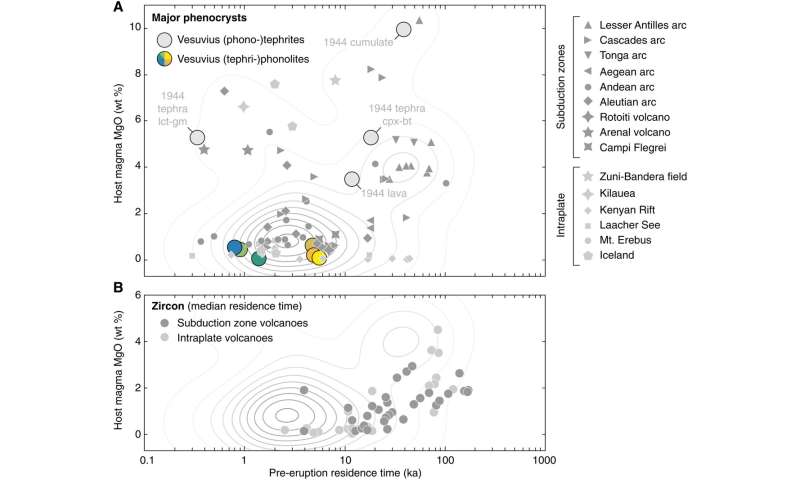
Time scales of magma storage beneath Somma-Vesuvius and other volcanoes worldwide as a function of magma composition. (A) Major phenocryst residence times depending on magma composition. Host magma composition (bulk rock or glass MgO) is plotted as a function of crystal residence time for Somma-Vesuvius phonolites (this study), phonotephrites (24), and a global compilation of arc (dark gray) and intraplate (light gray) volcanoes [modified from Cooper and Kent]. Gray lines are density contours of a two-dimensional kernel density estimate of the global data compilation. (B) Zircon residence times depending on magma composition. Host magma composition is plotted as a function of median zircon residence time for various subduction-related and intraplate volcanoes. Density contours for the major phenocryst data plotted in (A) are shown for comparison. Science Advances 10.1126/sciadv.abk2184
Outlook
In this way, Jörn-Frederik Wotzlaw and colleagues detected the time-scales and conditions of magma storage before Plinian and sub-Plinian eruptions of Somma-Vesuvius using garnet with a well-recovered phonolite mineral assemblage and crystallization sequence. The garnet crystallization ages provided tight constraints on the upper residence time of the phonolithic magmas before eruption. The team compared the mean pre-eruption residence times, as the difference between the mean garnet crystallization age, and the eruption age. Most importantly, the pre-eruption residence times decreased throughout the lifetime of the volcano. The team assessed the cumulative dynamics across four volcanic sites including Mercato, Avellino, Pompeii and Pollena and showed how prolonged phonolite storage regulated the eruption dynamics to provide insight to the long-term evolution of the Somma-Vesuvius plumbing system. The cumulative research work provides a framework to predict future volcanic activity based on past eruptive products to proactively assess future hazards.
More information: Jörn-Frederik Wotzlaw et al, Garnet petrochronology reveals the lifetime and dynamics of phonolitic magma chambers at Somma-Vesuvius, Science Advances (2022). DOI: 10.1126/sciadv.abk2184
B. Scaillet et al, Upward migration of Vesuvius magma chamber over the past 20,000 years, Nature (2008). DOI: 10.1038/nature07232
Journal information: Science Advances , Nature
© 2022 Science X Network



















